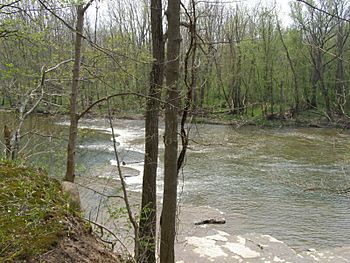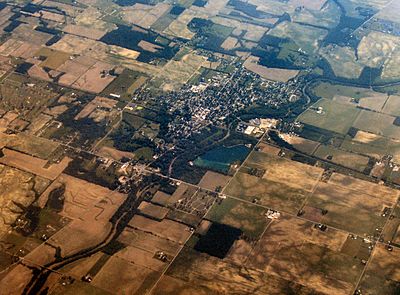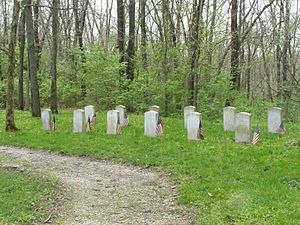Mississinewa River facts for kids
Quick facts for kids Mississinewa River |
|
|---|---|

The Mississinewa River near Marion, Indiana
|
|
| Country | United States |
| Physical characteristics | |
| Main source | Darke County, Ohio |
| River mouth | Wabash River near Peru, Indiana |
| Length | 120 mi (190 km) |
The Mississinewa River is a tributary of the Wabash River in eastern Indiana and a small portion of western Ohio in the United States. It is 120 miles (190 km) long and is the third largest tributary behind the White and Little Wabash Rivers, only slightly larger than the Embarras and Vermilion Rivers. Via the Wabash and Ohio rivers, it is part of the Mississippi River watershed.
During the War of 1812, the river was the site of the Battle of the Mississinewa, which pitted United States forces against the Miami Indians. Two oilers of the U.S. Navy have been named USS Mississinewa after the river. The word Mississinewa is partly derived from the Miami Indian word nimacihsinwi which means “It lies on a slope”.
Contents
Course

The Mississinewa River has its headwaters near the Indiana state border in northwestern Darke County, Ohio, within 2 miles (3.2 km) of the start of the Wabash. Both rivers start out as drainage ditches for local farms and have very little water during drought in this immediate area. After exiting Darke County the Mississinewa flows for the remainder of its course in Indiana. It initially flows westward in a heavily straightened and channelized course through northern Randolph and Delaware counties; it turns northwestward in Delaware County and flows through Grant, Wabash and Miami counties. It joins the Wabash River from the south in Miami County, about 2 miles (3 km) east of Peru.
Along its course the Mississinewa flows past the towns of Ridgeville, Albany, Eaton, Matthews and the cities of Jonesboro, Gas City and Marion.
A series of limestone columns known as the "Seven Pillars of the Mississinewa" stands on the north side of the river about three miles (5 km) southeast of Peru in Miami County.
The Indiana Central Canal was to use the river for part of its length, but was never completed.
Dams
Near its mouth in Miami County, the U.S. Army Corps of Engineers Mississinewa Lake Dam causes the river to form Mississinewa Lake. The dam was built for flood control in 1967.
Two related and nearby lakes in north-central Indiana, created at approximately the same time as part of the same project, were formed when dams were constructed on the nearby Salamonie River and Wabash River. The Salamonie and Mississinewa join the Wabash downriver from the dam on the Wabash. The dams were designed to reduce flooding in southern Indiana and nearby towns.
History
Mississinewa Battlefield
On Dec. 17, 1812, Lt. Colonel John B. Campbell with 600 mounted troops arrived at this site under orders to destroy the Miami Indian Villages along the Mississinewa River from here to the present site of Peru. The destruction of the village on this site resulted in the loss of the lives of two soldiers and eight Indians. Following the attack here, Campbell's force proceeded two miles down the river and destroyed two more villages before returning here to camp for the night. Shortly before dawn on December 18, a force of Miami Indians attacked Campbell's camp. The two-hour battle resulted in 10 soldiers being killed and 48 wounded. Approximately 40 Miami and Delaware Indians gave their lives in the defense of their lands. Having over 100 of his horses killed and fearing a second attack, Campbell ordered his troops to return to Fort Greenville late in the afternoon of the 18th. This action was one of the first ordered by General William Henry Harrison during the War of 1812.


